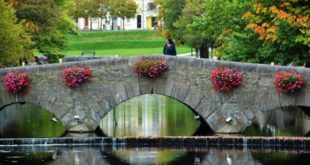After the recent trip around the country, I can tell you that Bulgaria has been a pleasant surprise as a destination.
Before traveling, he knew practically nothing of the attractions of the country, beyond the Rila Monastery , a place declared World Heritage by Unesco .
But now I can tell you that I have discovered very interesting sites, and a country where it is really worth making a tour of tourism .
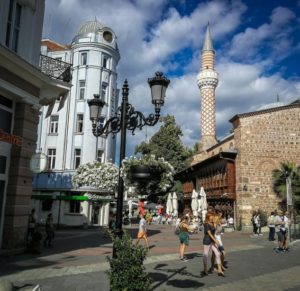
In this trip the objective at the time of its design was to make a route through the essential places to visit in Bulgaria , in a varied itinerary in which the visit of the main destinations was not lacking.
On this trip, historical cities such as Plovdiv and Veliko Tarnovo have alternated, which have been prominent protagonists in the history of the country.
Also beautiful and charming villages , that show you the image of the most rural Bulgaria , as it is the case of Bozhentsi , Bansko or Triavna .
Historical sites such as the valley of the Thracian Tombs , and Orthodox monasteries , in addition to Rila, such as those of Bachkovo and Sokolski .
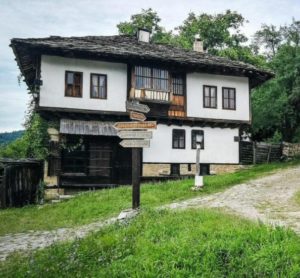
And, of course, natural regions with a special attraction that is part of the Bulgarian tradition, such as the Valley of Roses , in the absence of a future trip to know the region of the Rila Lakes .
What places to see in Bulgaria
In order to plan your future trip to Bulgaria I will highlight 15 attractive places that you should include in your route.
Sofia
Of course, when you travel to Bulgaria you will fly to Sofia , but my first advice is to dedicate as little time as possible to visiting the capital of the country.
The most interesting places in its historical center you can know well in half a day, which, taking into account the schedules of your return flights, you can even come well to make the visit on any of those days.
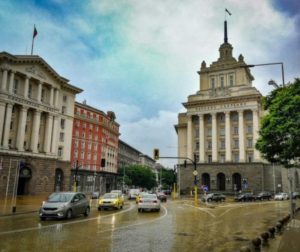
To emphasize the fourth century church , the oldest in Sofia, located in the Rotunda San Jorge , the great central courtyard of the current presidential palace.
Nearby is the great Mosque Banya Bashi , of the sixteenth century, shows the presence of the Turks in Bulgaria for several centuries, and in front, a large synagogue, the largest by its size that is preserved in Eastern Europe .
However, the great icon monument of Sofia is the Cathedral of St. Alexander Nevsky , built in 1912 in memory of the fallen in the Russo-Turkish War (1877-1878) that led to the departure of the Ottomans from Bulgaria.
Rila Monastery
The Rila monastery is, without a doubt, that kind of places that by knowing it, a trip to a destination is justified.
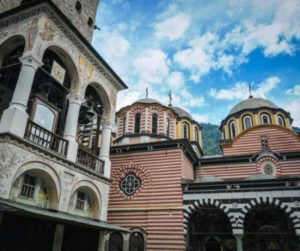
Lost in a mountain setting, among lush forests, and an hour and a half from Sofia , when you enter the fortified enclosure of the monastery you will be impressed by the image you see.
Although its origins go back to the 10th century, the current monastic complex was built in the 14th century and has become the spiritual center of Bulgaria .
The fact that the Ottoman sultans themselves protected him during the long occupation of that country by the Turks will serve you well.
The mural paintings that cover the church’s ceilings and walls are located in the large central courtyard that opens onto the secure complex that will focus your attention, as well as the great interior decoration of the same.
In the monastery museum you can see artistic objects from different periods of the monastery’s history.

Bansko
Not far from the monastery, an hour and a half to the south, you have an example of a mountain village located at the foot of the mountains of Pirin , where one of the country’s national parks extends .
This is Bansko , a beautiful town where you will have good examples of rural architecture , and a place visited in winter because it is a lodging center with hotels and resort for those who go to the ski stations of these mountains.
There you will see examples of the fortified houses of the 18th and 19th centuries, with thick stone walls and small windows.
You can also visit a church with characteristic orthodox decoration, whose tower is separated from the main building, as is usual in most Bulgarian Orthodox churches .
This was due to the fact that during the occupation of the country, the Turks prohibited the construction of bell towers, which were erected after their expulsion.

Plovdiv
Although up to now I suppose that, as in the case, Plovdiv was an unknown place, in the next months we will have the opportunity to hear about this town because it has been declared European City of Culture 2019 by the European Union .
I’ll tell you that Plovdiv is one of the oldest cities in Europe since it goes back to 4,000 BC when the Thracians from Asia came to this region of eastern Europe .
In this historic area you will also see small museums and various craft shops.
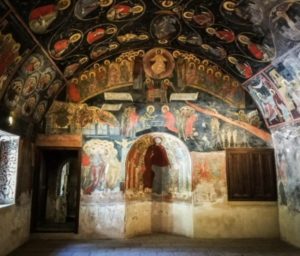
Bachkovo Monastery
Apart from Rila, one of the Orthodox monasteries that you can meet in Bulgaria is Bachkovo .
Located less than an hour south of Plovdiv , in the Valley of the Kings , the Bachkovo monastery was founded in the tenth century, although during the first waves of Turkish occupation it was destroyed.
Rebuilt at the end of the 15th century, its great attraction is the numerous wall paintings, most of the nineteenth century, although the artistic jewel of the site is the old refectory where the monks ate, which preserves 17th century paintings.
You will also be struck by the golden iconostasis of the seventeenth century of the main of the two churches in the monastery.
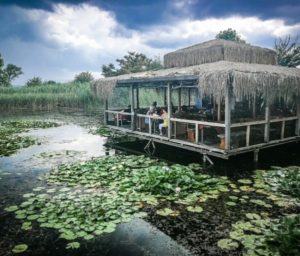
Valley of the Roses in Bulgaria
If you travel in May, your route through Bulgaria will be incomplete if you do not visit the one known as Valle de las Rosas , an area located north of the great plain where Plovdiv is located , which is the place in the world where more rose oil is produced.
Already at the foot of the Balkan Mountains , this valley in spring is covered with roses, which are collected for the production of rose oil following a tradition that goes back to the 17th century.
Known as liquid gold , since it is more expensive than gold (one liter of rose oil costs between 10,000 and 14,000 euros), the customers of the distilleries of this valley are the most prestigious cosmetic and pharmaceutical brands in the world.
On your trip to Bulgaria in May you can see the fields covered with roses, and during the whole year you can visit some of the distilleries where they tell you about this liquid gold and explain how it is produced.

Thracian tombs in Bulgaria
This area of the Stara Zagora region is also known as the Valley of the Thracian Kings because there are several tombs from the Thracian period.
These are archaeological monuments declared World Heritage by Unesco , which date back to the 4th and 5th centuries BC
As you circulate through the valley you can visit some of the 10 tombs that are cataloged and open to the public.
In these tombs were buried sovereigns of the Thracians or rich people, next to the woman who was considered the favorite and in the anteroom of it, his horse.
All of them have a different configuration, from the simplest to those that have several rooms,
There were tombs in which the person for whom it was destined did not enter, for he had died somewhere far away, although the objects and gifts that the whole community gave as a gift were kept.
Two of the Thracian tombs you can visit are the Kazakhstan tombs , which were found by chance in 1944 while shelters were being built.
And also that of Kostmatka , where you will see the original tomb, which is oriented towards the sun that entered to the bottom to illuminate the body.

Russian Orthodox Church of Shipka
As you head from the province of Stara Zagora to the province of Gabrovo,crossing the Balkan Mountains through the port of Shipka , when you start ascending you will find a large Russian Orthodox church .
It is the church of Shipka , Russian architectural style with golden domes, which is part of the Shipchenski monastery founded by the Russians in the late nineteenth century.
The church was completed in 1902 in commemoration of the aforementioned Russo-Turkish War , whose most bloody battles took place in the aforementioned port, and its construction was financed by the Russians.
You will see that it is a very nice building with cross-shaped nave and three apses.

Shipka Monument
Precisely also to commemorate such battles, in from the port of Shipka you can climb to the highest point of the mountain where a large monument is located.
When you park the car, to get to the Shipka monument you will still have to climb a very wide and long staircase that will lead you to the tower-shaped monument itself, which houses a museum.
Around it you will see various trenches with cannons that were used in that war.
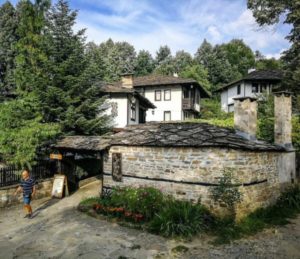
Rural architecture in Bozhensti
If there is a village to recommend for being the best example of rural architecture in Bulgaria , that is Bozhensti . considered an architectural reserve .
Located near the city of Gabrovo , and lost among mountains with lush forests, I tell you that in good measure, when you walk through its cobbled streets you will have the feeling of finding yourself in a village in the mountains of Asturias.
You will walk along paths between houses that in their construction combine the stone with white facades made of wood and with slate roofs, which are distributed in the forest, on the mountainside.
Undoubtedly, Bozhensti is a fairytale town whose attractiveness will give you the information that to access it you have to pass a barrier with a numerical control that in this way ensures that it is not invaded by tourists.
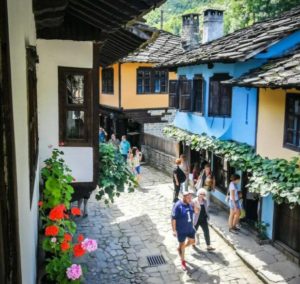
Artisans in the ethnographic museum Etara
Along the same line, outside the city of Gabrovo, there is the ethnographic complex of Etara , a place where in the form of a living museum you will see several examples of rural architecture in Bulgaria .
Founded in 1966, the base of this complex, now much visited by tourists, are the traditional houses lined up next to a river, where several artisans carried out various activities taking advantage of the strength of the waters.
In addition to the original houses and workshops , you will also see a group of houses that emulate the rural architecture of the country, where other artisans have settled.
In this way in the ethnographic museum of Etara you can see work from one of the most prestigious icons of Bulgarian artists today, to cutlery craftsmen, wooden objects, carpets or bagpipes.

Sokolski Monastery in Gabrovo
Also near the city of Gabrovo you can visit the Sokolski monastery , which was founded from a small wooden church that was built in 1833.
It is located in a natural park that protects a forest of beech trees, and although initially it was a monastery of monks, in 1944 the nuns of another monastery that was destroyed by the communists were transferred to it.
Since then Sokolski is a monastery of nuns of which, at present, only one remains.
When you enter the site you will see a beautiful garden with a circular stone fountain in the center of it.
But in particular you must go down to the small church next to the patio, which shows a great decoration with a golden iconostasis and wall paintings on walls and ceilings.
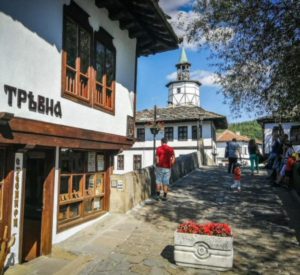
Tryavna
Another very beautiful place, almost a fairytale, that you can visit on a trip through Bulgaria is Tryavna , a small town of just 10,000 inhabitants, which is also very visited by tourists.
Located in this central region of the country, it is the best representation of the Bulgarian Renaissance period of the 17th century.
In Tryavna you will see houses from the seventeenth to the nineteenth centuries, and in your walk through its streets you will see beautiful architectural corners.
You can also visit a wooden carving museum in an 18th century house, Daskalova House , which is known and appreciated throughout Bulgaria for its wooden roofs.
The Tryavna Orthodox Church dates from the 19th century, when it was built to replace the original 11th century that had been destroyed by the Turks.
It is worth visiting inside because its iconostasis is, together with that of the Rila monastery , the most famous in Bulgaria.
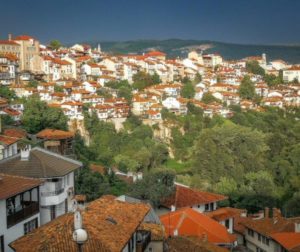
Veliko Tarnovo
Maybe you do not know, as I did before traveling to Bulgaria , that if there is a city with a lot of history in this eastern European country that is Veliko Tarnovo .
Located to the north of the country, it was the capital of Bulgaria in medieval times , until the Turks arrived in 1394.
The medieval Veliko Tarnovo stretched into three fortified enclosures on the hills between which a river meanders, and on the main hill stood a Royal Palace.
The current of Veliko Tarnovo occupies the hills where the Turks extended the city and has a spectacular location on the river, so that somehow you can remember the city of Cuenca with its hanging houses.
During your visit to Veliko Tarnovo, you should go looking for the best panoramic views of the city from the various viewpoints located on terraces of bars, restaurants and other establishments.
And you must also visit the old walled enclosure where the remains of the old Royal Palace are located .
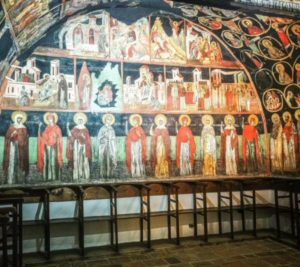
Arbanasi
Very close to Veliko Tarnovo you find another small village considered an architectural reserve, Arnabasi .
Also from the medieval era, its origin is due to the wedding of a Bulgarian czar with a Greek princess, who missed his country, so they invited family and friends of the same to go to reside in the town.
There, large houses were built, so that now in the visit of Arnabasi you willsee 17th century buildings that mix traditional Bulgarian and Greek architecture.
In Arnabasi you can visit a large house of that time, the House Konstantzaliev , as well as the church of the sixteenth century, with a curious stone building and flattened plant, without bell tower.
 Countries To Travel Travel Tips and Plans
Countries To Travel Travel Tips and Plans

